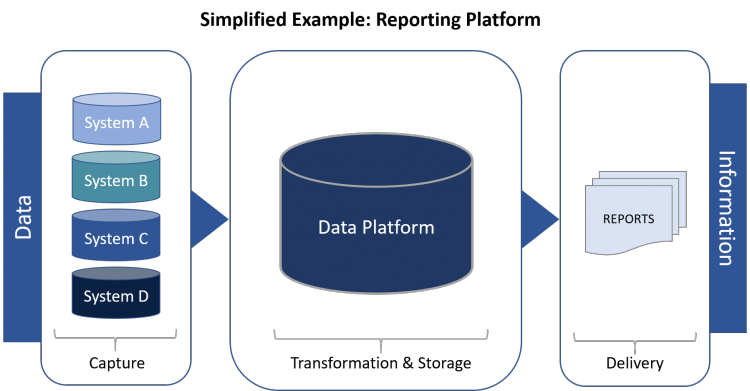IT Projects
IT Capital Projects, as defined in Policy FM11, Capital Projects, Capital Purchases & Internal Loans, adhere to a process to ensure alignment of initiatives and activities to support UBC’s strategic goals and objectives. The process outlines the stages, deliverables, and capital value-based approvals required for an IT capital project.
When planning to implement a new IT project, including for those IT projects that are not qualified as a 'Capital' project, proactive planning and consideration is required for the data stream to adequately resource the project and sustainment of the initiative post implementation. The recommendations below are particuarly important when the project involves Enterprise Data. For the purpose of this guide, Enterprise Data is defined as data that is shared or used by more than one department or faculty. Well-managed data is managed strategically, and this begins with the development of a Data Management Strategy.
Data Management Strategy Planning
Strategic planning, by definition, comprises two key elements: a strategy and a plan. A sound data strategy should align with UBC’s strategic plan, and by extension, the mission, vision, and values of the University, even if those connections are not explicitly stated. A successful data strategy supports the strategic plan through data structures and data-informed decision making that inherently promote the attainment of the University's goals.
Key components of a Data Management Strategy include data migration, data quality, and roles and responsibilities in alignment with UBC's Enterprise Data Governance program, with respect to data definition, use, access, storage, and destruction.
To get started, it is helpful to consider the data project work stream as being comprised of three phases – capture, transformation and storage, and delivery – through which data flows, and is turned into information for decision-makers to utilize for operations or strategic action.

Data Management Strategy Checklist & Template
All sections identified below are required at a minimum for a Data Management Strategy Plan. This does not supercede or replace existing policies or guidance, but is intended to supplement other requirements for IT project planning including resourcing. Project sponsors are accountable for applying and understanding applicable policies and expectations for managing data that is in scope for the project.
Capture
Define data requirements: Consider how the data will be collected or created, unlesss the data already exists, whether internally at UBC, or externally. Stakeholder requirements for analysis and reporting should drive the identification of data requirements. Often times, reporting requirements are neglected, resulting in costly, and time consuming work arounds.
If the data already exists, the appropriate source for each data element needs to be identified, along with a qualitative and quantitative description of the quality of the data, with an initial mapping between the source and target systems to be completed.
- Is new data or terminology produced? If yes, have you consulted with the EDG team to update the University Data Model, and the University Glossary?
- What are the regulatory requirements for collecting, creating, using, sharing, accessing, storing, and retaining the data?
- What is the volume of the data in-scope?
- Have data standards been identified for some or all data elements?
- Have business rules been defined? How will the data be validated?
- For existing data, what are the sources of the data, the systems of record for each data element?
- How is the data created or acquired by UBC, and how is it changed?
- What is the quality of the source system data? Has the data been profiled?
- Source data is mapped to target system?
Transformation and Storage
The next phase includes considerations for how the data will be moved, consolidated, and made interoperable - the ability to be exchanged between systems. Data migration refers to a one-time movement of data from one system to another, and comprise of one of the following:
- Movement of data from a legacy application to a new application (what is the legacy system data retirement plan?)
- Upgrade from previous to new version of an application
- Consolidation of data from multiple instances
The considerations below are also applicable when new data is created, but is intended to be connected to other enterprise systems.
- How will the data be moved, extracted, or called from the source system?
- What is the frequency of the data exchange? Batch (event-based) or real-time?
- How will the data be backed-up and recovered?
- What is the retention of the data? What is the retention of the backup copies?
- What are the data quality rules, and have they been defined at data element, attributes and relationships?
- How will data quality, accuracy, and consistency be maintained over its lifecycle?
- Does the data need to be converted? This includes format, structural, and semantic conversions.
- Will the data need to be de-duped? (Remove duplicate records/data in target system)
- Are there any specific requirements for storing the data?
Delivery
How will the data be managed to ensure its security in transit and at rest, such that it is:
- Confidential: Data is only accessed and used by only those who are authorized.
- Integrity: Unauthorized changes to the data are not authorized, and changes are tracked, logged, and detected.
- Availability: Data is accessible when authorized users need it, and removed when they don't.
- Are there any access restrictions for the data you are collecting?
- What are the uses of the data?
- Is access provided based on role?
- How will user responsbilities be established and communicated?
- Does role based training need to be developed?
Data Management Planning Template